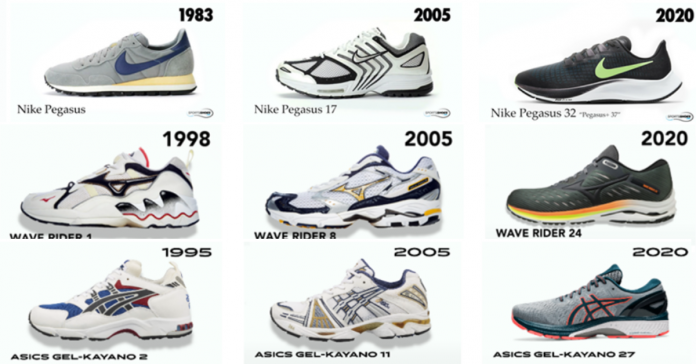In light of Covid-19 restrictions, more and more people have turned to pounding the pavements as an alternative to their usual gym, sporting or fitness activities. This is reflected in search demand for running shoes, which is up 56% YoY.
With running shoes having advanced so far in terms of design, build and technology, let us take a nostalgic look back at some of the most iconic running shoes of the past 40 years, portraying the evolution of Nike Pegasus, Mizuno Wave Rider and the Asics GEL-Kayano from their first release to their latest iterations.
Nike Pegasus
First launched in 1983 and named after the winged horse from Greek mythology, the Nike Pegasus was designed to embody quickness, movement and the idea of flying on air. After 37 years of innovation, and constant evolution Nike has turned myth into legend.
The Pegasus has earned its place in the history books and has become Nike’s biggest and best-selling shoe of all time. You can see key evolution moments for the shoe below:
1983: The Nike Pegasus is launched. The model was originally called the Air Wedge Trainer, as it was the first to feature an Air Wedge which was designed to increase shock absorption.
1988: The model becomes Nike’s best-selling shoe.
1991: Steve Spence, Long-distance runner and bronze-medal winner at the World Championships in Tokyo endorses the shoe as one of his favourites.
1993: A decade after its release, the model has sold 17 million pairs.
1996: Visible air is added to the shoe within the visible Air-Sole part in the heel.
2000: After a 3-year wait the Pegasus is reborn! This version of the shoe features a full-length Air Sole unit and is the first to show the “Bowerman Series” tag. Bill Bowerman was the original co-founder of Nike.
2004: The women’s version is adapted to cater to the female foot – a curvier version where medial support is increased.
2005: Long-distance champion Bernard Lagat wins 1500m with a record time of 3:33:34. He had trained in Nike Air Pegasus leading up to the event, running 90 miles per week in a pair.
2008: The Pegasus+25 is released and is “plus enabled”, allowing you to add a sensor into the shoe which reports downloadable information such as distance run and speed to your Ipod.
2009: The Nike Air Pegasus Berlin is released to commemorate the fall of the Berlin Wall which occurred in 1989.
2018: The design moves on to take inspiration from the Vaporfly 4% and Breaking 2 campaign borrowing the fin shape midsole with a heel lip.
2020: The Pegasus 37 is the latest model to be released, with the biggest changes taking place underfoot. Nike switches from Cushlon to React foam, which is lighter and more durable, enabling a comfier underfoot experience. The Zoom Air bag is moved to underneath the forefoot and made to be twice a thick to provide more spring with each stride.
Mizuno Wave Rider
Named the Wave Rider due to its wave-shaped unit in the midsole of the shoe, The Mizuno Wave Rider was created to propel the runner forward, rather than focus on cushioning the impact of each stride. First released in 1998, the shoe was created to differentiate from other popular brands which were using gel and air to cushion the blow of a runner’s stride.
The ocean’s waves were a source of inspiration for the model. Waves gather momentum from winds which push breakers towards the shore and in the same way, the wave plate of the Mizuno Wave Rider redirects downward energy forwards. You can see key evolution moments for the shoe below:
1998: The Wave Rider is released.
1999: The shoe becomes a Mizuno bestseller due to its re-designed Wave Plate featured in the mid-sole.
2001: The shoe receives its first temperature regulation technology called the Intercool, a holed ventilation system which protects feet from blisters.
2009: The first women’s iteration of the shoe is released, with a narrower, more flexible design.
2012: SmoothRide technology is introduced to provide increased propel efficiency.
2019: The Wave Rider 23 is released, sporting a cleaner overall look than previous models.
2020: Mizuno has completely recreated the latest model with rich upper upgrades, a rounded heel collar for an irritation-free fit and an Enerzy heel wedge for improved cushioning. Due to these upgrades, the Rider 24 has a 12% Enerzy return up from the previous model, providing a much smoother ride with more cushioning.
ASICS GEL-Kayano
Named after its creator Toshikazu Kayano, the ASICS GEL-Kayano was created in 1993 as a cutting-edge shoe for any long-distance runner. The shoe was created to perform as a hybrid, ideal for both long-distance running outdoors and indoor gym training.
The shoe utilises ASICS’ impact-reducing and performance-enhancing technologies and was inspired by the aggressive motion and firm body of the stag beetle. Key evolution moments are listed below:
1993: The eponymous GEL-Kayano is released as a flagship for long-distance runners.
1999: Until this point, aesthetics dominated the design of the shoe. With the release of the GEL-Kayano 5, visible technology began to be added such as the Duomax sole, double visible GEL and the teardrop tongue.
2000: The GEL-Kayano features scientific production by the Institute of Sports Science.
2002: ASICS add lateral rearfoot flex grooves to smooth the runner’s stride.
2004: The GEL-Kayano is picked as the Japanese athletes’ delegation shoe for Athens Olympic Games.
2009: An eco-friendly version of the shoe is released as a partnership with MIT, with reduced C02 emissions and more environmentally friendly materials used in the production.
2018: ASICS introduced FLYTEFOAM, a spongey, highly resilient material.
2020: The Gel-Kayano 27 is released to provide luxurious stability. This latest version is softer and smoother, with softened midsole foams and slightly deeper forefoot flex grooves, allowing for an easier toe-off. The heel design has also been updated to better isolate impact for a softer feel at foot strike.
Above content and graphics are contributed by SportsShoes.com


